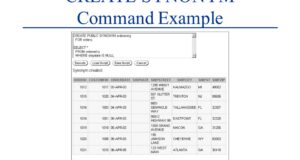REQUEST COMPLIMENTARY SQLS*PLUS LICENCE
Oracle Synonym

In Oracle PLSQL Synonym is an alternative name for objects such as tables, views, sequences, stored procedures and other database objects.
Typically, you use synonyms when you provide access to an object from another schema, and you don’t want users to worry about which schema the object belongs to.
Create (or Replace) Synonym
You can create a synonym so that users do not use a table name prefix with the schema name when using a table in a query.
Syntax for creating Oracle/PLSQL synonyms
CREATE [OR REPLACE] [PUBLIC] SYNONYM [schema .] synonym_name
FOR [schema .] object_name [@ dblink];
OR REPLACE
Allows you to recreate a synonym (if it already exists), without having to issue the DROP synonym command.
- PUBLIC – This means that the synonym is public and available to all users. Remember that the user must first have the appropriate privileges for the synonym object.
- schema – The appropriate schema. If this phrase is omitted, Oracle assumes that you are referring to your own schema.
- object_name – The name of the object for which you are creating the synonym. It can be one of the following objects:
- table
- view
- sequence
- stored procedure
- function
- package
- materialized view
- java class schema object
- user-defined object
- synonym
Let’s consider an example of how to create a synonym in Oracle/PLSQL
CREATE PUBLIC SYNONYM suppliers
FOR app;
This first example of CREATE SYNONYM demonstrates how to create a synonym with the name. Now, users of other schemes can reference the table with suppliers without the prefix of the scheme name and table name.
SELECT *
FROM suppliers;
If this synonym already exists and you want to recreate it, you can use OR REPLACE as follows:
CREATE OR REPLACE PUBLIC SYNONYM suppliers
FOR app.suppliers;
Drop synonym
After the synonym was created in Oracle, you will need to remove it at some point.
drop synonym syntax in Oracle/PLSQL
DROP [PUBLIC] SYNONYM [schema .] synonym_name [force];
- PUBLIC – Allows you to remove the public synonym. If you specified a PUBLIC, you may not need to specify a schema.
- Force – This will force Oracle to remove the synonym, even if it has dependencies. This is probably not a good idea to use force, as it can invalidate Oracle objects.
Let us consider an example of how to remove synonym in Oracle/PLSQL
For example:
DROP PUBLIC SYNONYM;
The DROP operator will delete the synonym with the name of suppliers that we defined earlier.
Oracle – SQL – Creating Synonyms
MORE NEWS
PreambleNoSql is not a replacement for SQL databases but is a valid alternative for many situations where standard SQL is not the best approach for...
PreambleMongoDB Conditional operators specify a condition to which the value of the document field shall correspond.Comparison Query Operators $eq...
5 Database management trends impacting database administrationIn the realm of database management systems, moreover half (52%) of your competitors feel...
The data type is defined as the type of data that any column or variable can store in MS SQL Server. What is the data type? When you create any table or...
PreambleMS SQL Server is a client-server architecture. MS SQL Server process starts with the client application sending a query.SQL Server accepts,...
First the basics: what is the master/slave?One database server (“master”) responds and can do anything. A lot of other database servers store copies of all...
PreambleAtom Hopper (based on Apache Abdera) for those who may not know is an open-source project sponsored by Rackspace. Today we will figure out how to...
PreambleMongoDB recently introduced its new aggregation structure. This structure provides a simpler solution for calculating aggregated values rather...
FlexibilityOne of the most advertised features of MongoDB is its flexibility. Flexibility, however, is a double-edged sword. More flexibility means more...
PreambleSQLShell is a cross-platform command-line tool for SQL, similar to psql for PostgreSQL or MySQL command-line tool for MySQL.Why use it?If you...
PreambleWriting an application on top of the framework on top of the driver on top of the database is a bit like a game on the phone: you say “insert...
PreambleOracle Coherence is a distributed cache that is functionally comparable with Memcached. In addition to the basic function of the API cache, it...
PreambleIBM pureXML, a proprietary XML database built on a relational mechanism (designed for puns) that offers both relational ( SQL / XML ) and...
What is PostgreSQL array? In PostgreSQL we can define a column as an array of valid data types. The data type can be built-in, custom or enumerated....
PreambleIf you are a Linux sysadmin or developer, there comes a time when you need to manage an Oracle database that can work in your environment.In this...
PreambleStarting with Microsoft SQL Server 2008, by default, the group of local administrators is no longer added to SQL Server administrators during the...















